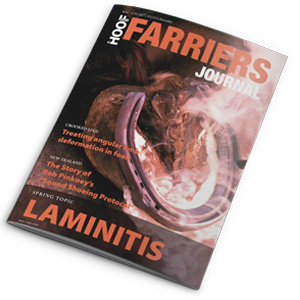
Do stance and movement of a laminitic horse indicate if the horse is a sinker vs having coffin bone rotation?
German farrier Volker Schmidt thinks so-read about his experience on how to tell the difference:
Laminitis
In many countries, the first warm days are synonymous with the start of the “laminitis season” for farriers and veterinarians.
That being so, The Farriers Journal decided to meet master farrier Volker Schmidt for an Interview. Schmidt is known as one of the most profound experts on equine laminitis. He has this reputation not only because of the positive results of his laminitis treatments, but also because he is well-known as a horizontal thinker who is able to combine traditional concepts with new ideas.
Due to his experience, he is not afraid to depart from typical treatment approaches and embrace unusual concepts.
The Farriers Journal: What is important to you when you start to work on a laminitis case?
Volker Schmidt: I insist on talking directly to the veterinarian. The horse owner does not give false information on purpose, but experience tells me that s/he usually is not able to transmit information between farrier and vet without mistakes.
The Farriers Journal: Besides the typical questions, -what do you want to know before you start a treatment?
Volker Schmidt: The following points are very important to me:
How is the horse standing?
Experience shows that the classical laminitis position with the front legs pushed out in front and hind legs well up under the body is found mainly in horses with (beginning) coffin bone rotation. The forward position of the legs and the increased loading of the heel area have a wedge-like effect in penetrable ground. This reduces the tension of the deep digital flexor tendon, thereby countering the bone rotation caused by the pull of this tendon. The extremely painful area below the tip of P3 is likewise loaded less thanks to this position. Another effect is to reduce the leverage that affects the toe wall by positioning the hoof more upright. The horse tries to counter the pull on the toe wall, which is no longer solidly attached through laminae to the coffin bone.
If horses show a lesser degree of the typical forward position of the limbs, but do seem generally extremely stiff due to pain, we are often confronted with a sinker. As all areas of the coffin bone get closer to the sole, increased loading of the heel area brings less relief. Reducing the pull of the DDFT also seems to have less effect on these horses. The classical sinker therefore tries mainly to avoid all movement, and especially turns.
Obviously, there are mixed cases with sinking and rotation at the same time. Assessing such cases by the horse’s stance is more difficult.
How does the horse move?
Answering this question takes the same approach as the first one. Typically, horses with coffin bone rotation in the acute-chronic phase show clear heel landing. As with the standing position, the reasons are an attempt to unload the painful toe area, reduce the pull of the DDFT, and reduce the leverage on the toe of the hoof. In chronic cases with rotation the heel landing often continues as the horse tries to land according to its new, more upright toe bone axis.If horses walk very stiffly without strong heel landing but show extreme pain when turning, these signs are indicative of a sinker. In the case of a sinker the laminae are destroyed not only in the toe area but in the quarters as well. As a result, any turning movement is extremely painful and harmful. Furthermore, it is important to know which breed or type of horse you are dealing with.
Many pony breeds have a stronger tendency to develop laminitis due to overfeeding, but they also often tend to heal more successfully than their more Thoroughbred-influenced cousins. Modern hot-blooded sport horses also have less of a tendency to develop laminitis. This is due as well to different management in top class sport stables. However, when they are affected, the course of the disease is often more problematic.
Generally speaking, the chance of successful treatment is smaller when the horse has already been treated for laminitis in the past. First-time cases have a better prognosis.
-
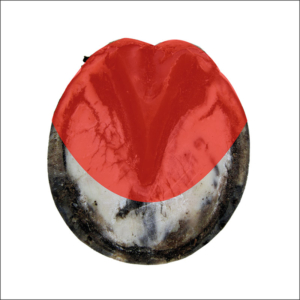
Bearing surface area in the case of a sinker when bandaged – Padding in front of the furcal apex but behind the edge of the P3
-
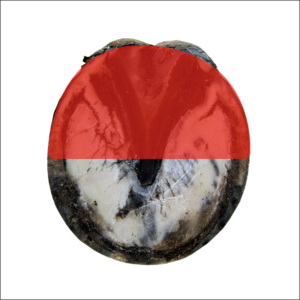
Bearing surface area in the case of P3 rotation when bandaged
-
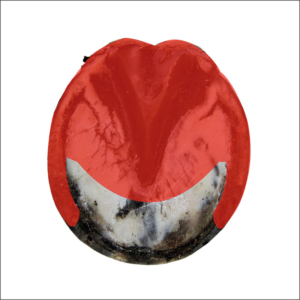
Bearing surface area in the case of a sinker when shod – Padding in front of the furcal apex but behind the edge of the P3
-

Loaded area bandage P3 rotation
-
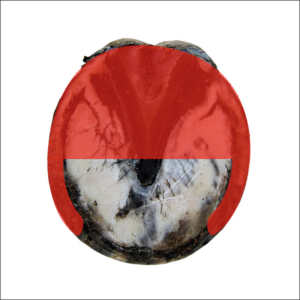
Bearing surface area in the case of P3 rotation when shod
-

Loaded area bandage sinker
